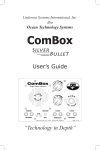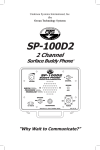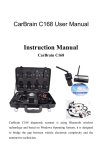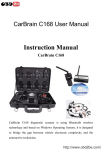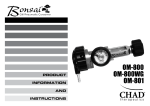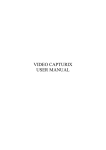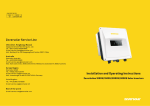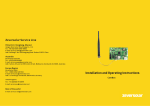Download ComBox - Ocean Technology Systems
Transcript
Undersea Systems International, Inc. dba Ocean Technology Systems ComBox Silver Bullet User’s Guide “Technology in Depth” - NOTICE This manual and the information contained herein are provided for use as a maintenance and operation guide. No license or rights to manufacture, produce, and/ or sell either the manual or articles described herein are given. Undersea Systems International, Inc., dba Ocean Technology Systems hereinafter referred to as OTS, reserves the right to change specifications without notice. It is recommended that all users read and fully understand this manual before using the Combox Silver Bullet. All statements, technical information, and recommendations herein are based on tests we believe to be reliable, but the accuracy or completeness thereof is not guaranteed; and the following is made in lieu of all warranties, expressed or implied, including the implied warranties of merchantability and fitness for purpose: Seller’s and Manufacturer’s only obligation shall be to replace such quantity of the product proved to be defective. Before using, the user shall determine the suitability of the product for intended use, and the user assumes all risk and liability whatsoever in connection therewith. Neither Seller nor Manufacturer shall be liable either in tort or in contract for any loss or damage—direct, incidental, or consequential—arising from the use of or the inability to use the product. No statement or recommendation not contained herein shall have any force or effect unless it is in an agreement signed by officers of the Seller and Manufacturer. - IMPORTANT SAFETY NOTICE (Please read before using the product) It is absolutely essential that all operators are properly trained and equipped and fully understand this user’s manual before attempting to use the Combox Silver Bullet. While the Combox provides the diver with good underwater communications, it does not change or eliminate the potential hazards of diving. Refer to the Library page of our Web site, www.oceantechnologysytems.com, for a list of any changes made to this manual since its publication. Copyright © 2008 by Undersea Systems International, Inc., dba Ocean Technology Systems. All rights reserved. Specifications are subject to change without prior notice. 506076-000 Rev. C Table of Contents Section 1: Introduction ..............................................................................1 Section 2: Specifications ............................................................................ 2 Section 3: Functions . ................................................................................. 3 Section 4: Two-Wire Mode......................................................................... 5 Section 5: Batteries ....................................................................................7 Section 6: Helpful Hints........................................................................... 11 Limited Warranty ....................................................................................13 Figure: 1.................................................................................................................4 2.................................................................................................................6 3...............................................................................................................10 i SECTION 1 INTRODUCTION Congratulations! You have just purchased the finest, state-of-the-art hard-wire intercom in the world. Your new ComBox Silver Bullet One-Diver Air Intercom represents advanced technology and innovation--the choice of discriminating divers throughout the world. Please take the time to read this owner’s manual. With proper care and use, your OTS product will provide you with the ultimate in high-quality communications and reliability. The ComBox is a compact, self-contained One-Diver Air Intercom providing two-wire communications between the operator and a diver. The package may be small, but the ComBox offers 20 watts of power! This manual discusses Specifications, Functions, Two-Wire communications, Batteries, Helpful Hints, and Warranty information. These guidelines and illustrations are presented to assist you. If you need additional information, do not hesitate to consult with your local OTS dealer or representative. If you need additional assistance, contact: Undersea Systems International, Inc., dba Ocean Technology Systems 3133 W. Harvard Street, Santa Ana, California 92704. Toll-free (800) 550-1984, Telephone (714) 754-7848, Fax (714) 966-1639 [email protected] • www.oceantechnologysystems.com 1 SECTION 2 SPECIFICATIONS Power Output: 20 watts Frequency Response: 600 to 12,000 Hz Cabinet Material: ABS plastic Front Panel: 1/8” ABS plastic Size: Weight: 3.5 lbs. (with 16 AA alkaline batteries) Width: 9.0 inches Depth: 3.4 inches Height: 3.6 inches Battery Life: 10 hours continuous use Battery Type: 16 AA alkaline batteries or two RB-11 NiMH battery packs (user must modify foam battery holder) Battery Chargers: RC-18: 120 VAC, 60 Hz input; 14.7 VDC output; max. load 500 mA RC-16: 120 VAC, 60 Hz input; 14.7 VDC output; max. load 170 mA RCS-16: 90–260 VAC, 50–60 Hz input; 21 VDC output; max. load 900 mA; connects directly to battery, for International use. RCS-18: 90-260 VAC, 50-60 Hz input; 21 VDC output; max. load 900 mA; charges through front panel, for International use. 2 SECTION 3 FUNCTIONS (See Figure 1) 1) Panel Speaker Heavy-duty panel speaker provides maximum audio power for overriding surrounding noise. 2) Headset Allows the use of a headset or headset with boom microphone. 3) Remote PTT Allows the use of a remote Push-to-Talk (PTT) control or headset PTT. 4) Record Out Permits Tender to record diving operations. 5) Diver Umbilical The Diver microphone/earphone communication cable is connected here. 6) 12-Volt External Power Allows Tender to use a 12-volt alternate source or charge the optional rechargeable batteries. Note: For charging, 14.7 to a maximum of 15 volts are needed. 7) Diver-to-Tender Volume Controls volume of Diver to Tender. 8) Push-to-Talk Button used for Tender to talk to Diver. 9) Tender-to-Diver Volume Turns unit on and controls Tender volume to Diver. 10) Panel screw One of four front panel screws. 3 Figure 1 4 SECTION 4 TWO-WIRE MODE In the two-wire mode, the two wires within the diver communication cable are connected to the Diver Umbilical binding post located on the front panel of the ComBox (Figure 2). If a cable with four wires is used, two wires (one mic and one ear) are normally twisted together for one side of the binding post and the remaining two for the other binding post. This configuration allows the Tender to talk to the Diver or vice versa. The Diver’s microphone and earphone and the surface unit speaker both function as speakers and microphones. If a speaker is located in a diving bell or recompression chamber, the ComBox can be used as the communication link between the personnel inside the chamber and the outside tenders. When the system is used where conditions are noisy, the ComBox operator can use a headset with boom microphone (THB-CBX2); however, when using a headset with boom mic, the Tender must still use the Push-to-Talk (PTT) switch, located on the side of the headset. The Diver communication is the primary signal. When the ComBox is operating, you will constantly hear the Diver. However, when the Tender presses and holds the PTT button, the Tender’s signal becomes the primary signal and the Diver will hear him. When the Tender releases the PTT button, the Diver again will become the primary signal. While the Tender is depressing the PTT button, the Diver cannot be heard. Note: Four-wire mode of operation cannot be performed with the ComBox Silver Bullet. 5 Figure 2 Note: A headset with or without a boom microphone can be used with the ComBox Silver Bullet. However, they are not necessary. When a headset is used, the Tender must still use a Push-to-Talk (PTT) button to talk. 6 SECTION 5 BATTERIES The ComBox Silver Bullet One-Diver Air Intercom can be powered by either 16 AA alkaline batteries or 2 RB-11 rechargeable 12V nickel metal hydride (NiMH) battery packs. Note: Due to the self-discharge characteristics of Nickel Metal Hydride (NiMH) batteries, they should be charged upon receipt of the unit and at least once a month to maintain service life. 1) Batteries: For best results, use 16 AA alkaline batteries. We recommend the use of alkaline batteries. You can use standard AA dry-cell batteries in a pinch, but battery life will be greatly reduced. Also available as an option are the RB-11 12-volt NiMH rechargeable batteries. Note: Never apply external power or attempt to charge when Alkaline batteries are installed. This may result in damage to the unit. 2) Installation (Figure 3): To install the batteries, first loosen the four screws found on the front panel (Figure 1, #6). Carefully remove the front panel. If using AA batteries, connect the battery snaps to each 8-cell battery pack and install the packs into the foam holders. The (optional) NiMH batteries (RB-11) are installed the same way, but the foam between the batteries must be removed. When finished installing the batteries, replace the front panel, ensuring you have not pinched any wires. Tighten the front panel screws. 3) Charging rechargeable batteries: 7 When using the optional RB-11 NiMH rechargeable battery, you will attain the maximum performance of self-contained batteries. Although the use of two RB-11 batteries is recommended, the batteries are wired in parallel, and the system will operate for a limited period on one set. (However, to prevent a short-circuit, connect the battery snap to an 8-cell battery holder.) The batteries may be charged inside the ComBox. The (optional) RC-18 battery charger (RCS-18 for use Internationally) has black and red connectors on the ends of the wires. Attach these connectors to the 12VDC External Power connector on the front panel (Figure 1, #2). Connect the RC-18 charger to any 110-volt, 60-cycle power outlet and let it charge for no more than 14 hours. If using the RCS-18 charger, use a 90-260-volt, 50/60-cycle outlet. Full charge is completed in 4-6 hours. Note: While it has been OTS’ experience that NiMH batteries rarely pose an off-gassing problem, there may be a rare exception. To be 100% safe, it is recommended that two or three panel screws be loosened during the charging process. If this step is not followed, ensure that the front panel is not bulging or the speaker’s silver dome is not pressed toward the inside surface of the panel. This would be an indication of internal pressure. Wait at least 15 minutes after charging before you apply power, to allow any built-up gas to dissipate. Remember to retighten the panel screws before operation. Another option is to charge the RB-11 rechargeable batteries outside the ComBox unit using the optional RC-16 (for use in the U.S.) or RCS-16 (for use Internationally) charger. This option is especially useful for charging spare batteries that can be quickly swapped with drained ones to extend the use of the ComBox. To remove drained batteries and install charged ones, follow the applicable instructions in Part 2 of this section. To charge the batteries using the RC-16 or RCS-16 charger, connect the battery snap (on the adapter connected 8 to the charger’s 4-pin Amp connector) to the battery snap on the RB-11 battery. Connect the RC-16 charger to any 110-volt, 60 cycle power outlet and let it charge for no more than 14 hours. If using the RCS-16 smart charger, use a 90-260-volt, 50/60-cycle power outlet and let it charge for 4-6 hours for a full charge. (Important note: If using the RC-16 or RC-18 chargers, do not charge the batteries for more than 14 hours. Overcharging may cause excessive gas build-up. Before operating, allow a few minutes after charging for any gasses caused by charging to dissipate.) Note: When you receive your battery, it may have upgraded specifications from what is stated in this manual. Due to advancing battery technologies, we continually are upgrading our batteries and chargers. Contact OTS or your OTS dealer to find out the latest available battery and charger. 4) Alternate Power Source: The external receptacle (Figure 1, #2) provides an easy terminal for a marine or automotive 12-volt DC source. This terminal can also be used with any external power source providing 12 volts and a minimum of 3 amps capacity. Important Note: Whenever the batteries are not being used (e.g., with connection of external power or during transportation or storage), be sure to connect the battery snaps to the battery holder (without the batteries). This will prevent the battery snaps from contacting the internal electronics and shorting the circuit. 9 Figure 3 10 SECTION 6 HELPFUL HINTS 1) Before diving operations begin, check to verify Diver microphone, earphone(s), and wire connections are functioning properly. Verify that all top-side connections are properly and securely fastened. Verify that batteries are fresh or fully charged. Ninety percent of all problems in communications turn out to be a problem with one of the above. 2) Avoid excessive Tender-to-Diver volume. Most of the time, when there is too much volume, the diver will hear distortion and ask for more volume. Make sure the diver has his earphones directly over his ears. 3) If using a headset, make certain the headphone plugs are securely inserted into the jack. 4) Speak as close to the front panel speaker as possible. The further away you speak, the more distant you will sound to the diver. 5) Transport the ComBox Silver Bullet without the batteries installed. This will help prevent damage due to accidental dropping or vibrations. 6) During transportation and storage, loosen a couple of the panel screws to create a safety vent to equalize any pressure differentials due to temperature changes or altitude changes. Remember to retighten the panel screws before operation. 7) When using an optional headset with boom micro11 phone, keep the boom microphone as close to your lips as possible. 8) When using NiMH rechargeable batteries, it is recommended that two or three panel screws be loosened during the charging process. If this step is not followed, ensure that the front panel is not bulging or the speaker’s silver dome is not pressed toward the inside surface of the panel. This would be an indication of internal pressure. Wait at least 15 minutes after charging before you apply power, in order to allow any gas built up inside the unit to dissipate. Remember to retighten the panel screws before operation to protect the internal electronics from water damage. 9) When closing the lid of the ComBox housing, ensure that all binding posts are rotated completely clockwise. Otherwise, the posts interfere with the lid. 12 Undersea Systems International, Inc. dba Ocean Technology Systems LIMITED WARRANTY The Combox Silver Bullet is fully warranted against defects in materials and workmanship for a period of one year from the time of purchase. Our obligation under this warranty is limited to the replacement of any part or parts that prove to our satisfaction to have been defective and that have not been misused or carelessly handled. Labor is warranted for one year from time of purchase. The complete unit and/or part must be returned to our factory, transportation charges prepaid. We reserve the right to decline responsibility where repairs have been made or attempted by other than an Ocean Technology Systems factory-trained service center or properly trained personnel. In no event shall Ocean Technology Systems be liable for consequential damages. You can now register your product online at the OTS Web site. Just visit http://www.oceantechnologysystems.com/register1.html. Undersea Systems International, Inc. dba Ocean Technology Systems 3133 West Harvard Street, Santa Ana, CA 92704, USA Telephone 714-754-7848 • Toll-free 800-550-1984 • Fax 714-966-1639 E-mail [email protected] • Web www.oceantechnologysystems.com Copyright © 2008 by Undersea Systems International, Inc., dba Ocean Technology Systems. All rights reserved. Specifications subject to change without prior notice. 13 13
















